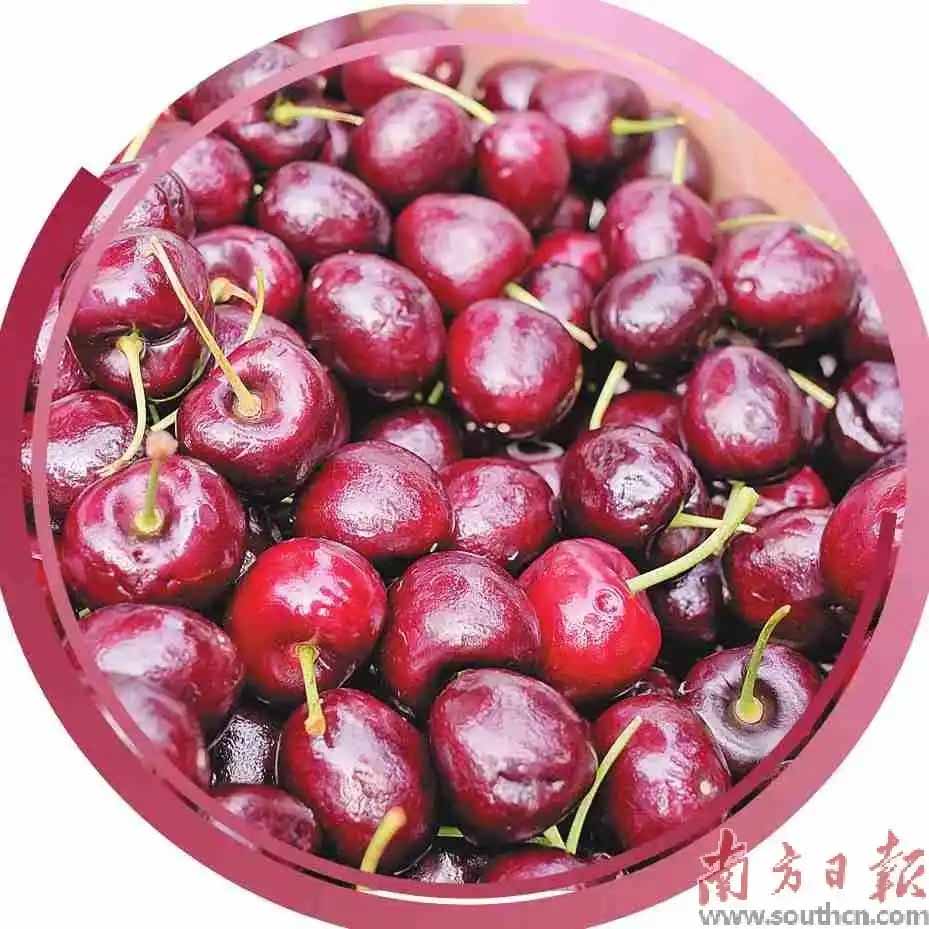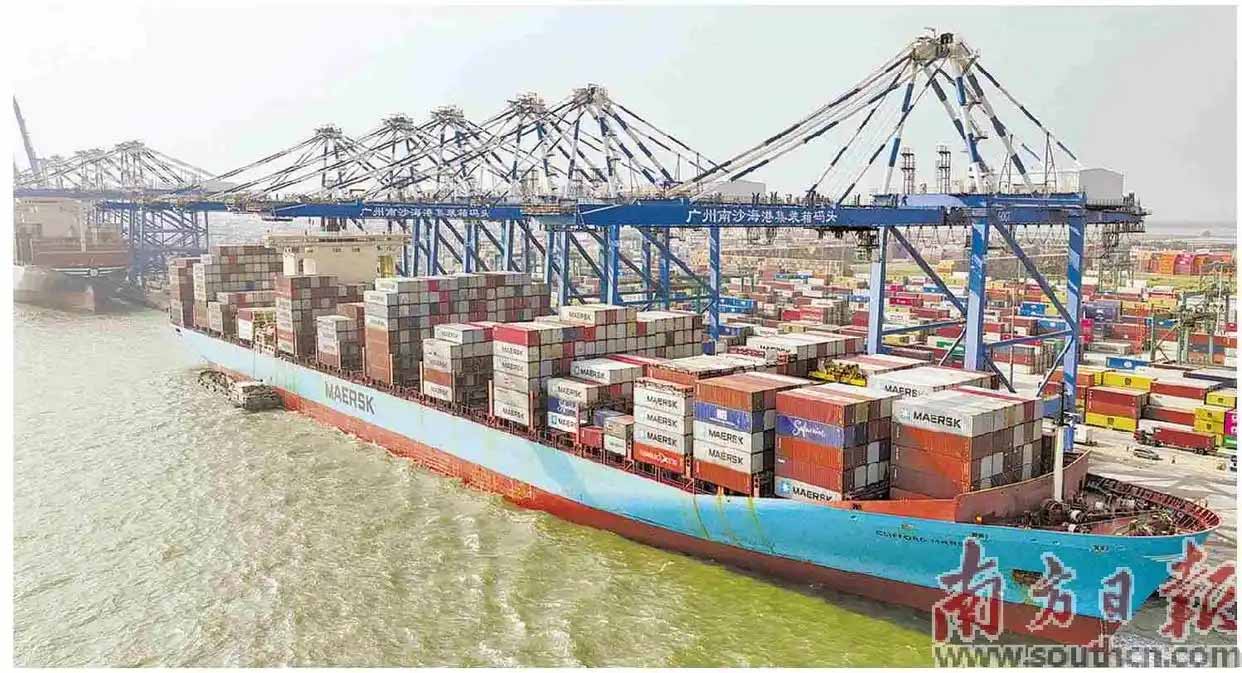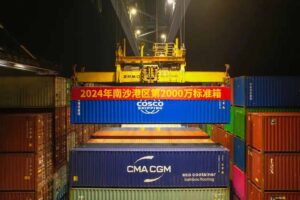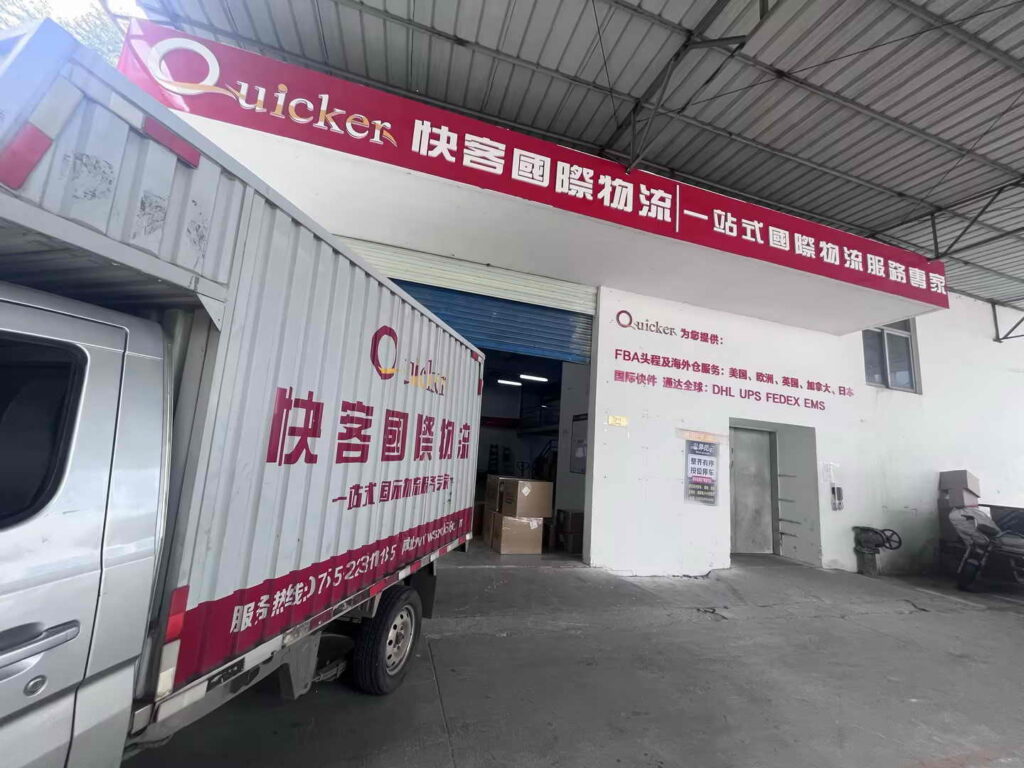It’s an article reprinted and translated from Southern Daily
January 27, 2025, 1:42 AM
Cherries from Nansha Port: A Sweet Addition to Chinese New Year

As the Year of the Snake approaches, 12 “cherry express” vessels are expected to dock at Nansha Port, bringing with them the season’s freshest cherries. These shipments highlight Nansha’s role as China’s largest cherry import port, a position it has solidified through speed, efficiency, and innovation.
Cherries, with their vibrant red hue, have become a perfect match for the festive atmosphere of Chinese New Year. This year, Chile has enjoyed an abundant cherry harvest, with over 92% of its production exported to China. The resulting supply surge has driven domestic prices down significantly—from an average of 210 yuan/kg to just 50 yuan/kg, a remarkable 76.19% drop. The sweet, crisp taste and affordable price have made cherries a top choice for many as a “foreign New Year treat.”
Chile began exporting cherries to China in 2008, and the 2017 upgrade of the China-Chile Free Trade Agreement, which eliminated tariffs on 98% of traded goods (including cherries), further boosted imports. These small fruits have become a symbol of China’s openness, showcasing how the country’s vast market offers immense opportunities to the world.
In the days leading up to the holiday, reporters visited Nansha Port to witness the bustling cherry import process and uncover the story behind its title as China’s “Cherry Import Hub.”

The Race for Freshness
At the heart of the Pearl River Delta’s “Golden Inner Bay,” a 100-kilometer radius is home to world-class ports like Guangzhou Port and Shenzhen Port. Together, these ports form a global logistics hub where goods from around the world converge, facilitating the flow of the global economy.
On January 23, at 8:39 AM, a 366-meter-long cargo vessel, the MSC ELAINE, emerged from the morning fog and docked at the second terminal of Nansha Port. This vessel, carrying 1,071 containers of cherries (approximately 24,000 tons), had departed from San Antonio, Chile, on a direct 22-day voyage to Nansha without any transshipment.
As soon as the ship docked, a highly coordinated “relay race” began to ensure the cherries reached consumers as quickly as possible.
Unlike standard containers, cherry containers require continuous power for refrigeration during their 20+ day journey at sea. The first task upon docking was to disconnect the power and refrigeration systems, a process that takes 1–2 hours depending on the number of crew members available.
Next came the unloading process, which has been optimized through technology. At Nansha Port, advanced systems using 5G and OCR (optical character recognition) technology enable real-time scanning of container information during unloading. This data is automatically linked to customs declarations, allowing for seamless sorting into direct delivery, storage, or inspection.
By 10:30 AM, the cherry containers from the MSC ELAINE had been processed and were ready for unloading. Chen Huanqing, a crane operator at the port, worked from a small 4-square-meter cabin suspended 52 meters above the ground. With precision akin to a claw machine, he controlled a crane to lift the 40-foot containers and place them on trucks in just 90 seconds per container.
“We call this process ‘hurdling,'” Chen joked. “I can handle up to 60 containers an hour when things are running smoothly. Cherry shipments are always on a tight schedule, so speed is essential to ensure freshness.”
Once the containers were loaded onto trucks, they had two destinations: those requiring inspection were sent to customs platforms, while others went directly to distributors. In some cases, cherries could reach distribution markets as quickly as two hours after unloading.
To further streamline operations, Nansha Port has integrated its terminal operating system (TOS) with the Nansha International Logistics Center’s cold chain project. This allows trucks to bypass intermediate storage yards and head straight to inspection platforms, saving an additional 10–20 minutes.
At 12:00 PM, the first cherry container arrived at the cold chain facility, where it awaited inspection alongside others.
Keeping It Fresh: Asia’s Largest “Refrigerator”
By 3:00 PM, the cherries were being inspected at the Nansha cold chain project, a state-of-the-art facility nicknamed “Asia’s Largest Refrigerator.” Inside its temperature-controlled environment, set at a constant 10°C, 15 inspectors worked diligently to ensure quality.
“We focus on the cherries’ quality, origin, and packaging to ensure they meet China’s import phytosanitary requirements,” explained Zeng Baiyi, Deputy Director of Nansha Customs. Inspectors also check for pests by crushing cherries into sugar water and examining the mixture under a flashlight for any harmful organisms.
The Nansha cold chain project is a comprehensive facility combining customs inspection, centralized supervision, standard cold storage, and refrigerated container stacking. According to Cui Yanwei, Business Director of Guangzhou Nansha International Cold Chain Co., the facility currently operates three cold storage units, each with 27 loading docks. With a daily inspection capacity of 300 containers, it is among the most advanced cold chain logistics centers in China.
To maintain freshness throughout the process, the facility features enclosed docks that match the containers’ internal temperature, minimizing any temperature fluctuations during inspection. Future expansions will add three more cold storage units, increasing total capacity to 460,000 tons.
Once customs clearance is completed, the cherries embark on their journey to markets and dining tables. The cold chain project also offers “direct-to-consumer” services in partnership with courier companies, ensuring same-day delivery for online orders. For larger shipments, cherries can be transported by train from the nearby Nansha Port South Station, connecting the port’s marine and rail networks.
The Taste of Freshness
Two hours from Nansha Port lies the Jiangnan Fruit and Vegetable Wholesale Market, one of China’s largest produce markets. Here, cherries are distributed to the Greater Bay Area and beyond, with daily sales reaching up to 200 containers (about 3,000 boxes per container).
“This year, cherry sales have been even better than before,” said Pan Xin, a manager at the market. Between January 1 and 25, the market’s daily cherry transactions averaged 4,011 tons, a nearly 50% year-on-year increase. The abundant supply has driven wholesale prices down to an average of 60 yuan/kg, making cherries more accessible to consumers.
At Nansha Port, however, cherries can be enjoyed even faster. Trucks can deliver cherries to the nearby Nansha Fresh Market in just 10 minutes, where customers can buy them straight from the port.
Zhuang Ping, a fruit vendor at the market, attributes her booming business to this proximity. “Standing at my shop, you can see the containers being unloaded from the port. That kind of freshness is unbeatable,” she said.
Zhuang frequently shares live updates with her customers, including photos of cherries being unpacked directly from containers. This transparency has built trust and loyalty, with customers often pre-ordering cherries before they even arrive. During the peak season, Zhuang receives over 500 messages a day and works until the early hours of the morning to keep up with demand.
Nansha Port’s innovative “dock-to-market” model has attracted 16 businesses to its fresh market, ranging from fruit vendors to cafes and specialty food stores. With events like the “Cherry Festival,” the market is becoming a hub for imported fruit sales, turning port traffic into economic growth.
A Global Gateway
Since launching its first “cherry express” route in 2019, Nansha Port has rapidly expanded its capabilities. It now operates 46 cherry-specific shipping routes in partnership with global shipping giants like Maersk and Mediterranean Shipping Company. Between 2019 and 2023, the port handled 300,000 tons of cherries.
This year, 12 cherry express vessels are expected to dock at Nansha, carrying 9,262 containers—approximately 30% of China’s total cherry imports. This represents a 67% increase from 2023, cementing Nansha’s position as the nation’s top cherry import port for the third consecutive year.
The humble cherry is more than just a fruit—it is a testament to the opportunities created by China’s openness and the efficiency of its modern logistics networks. As Nansha Port continues to innovate and expand, it is turning its strategic location in the Greater Bay Area into a gateway for global trade.






